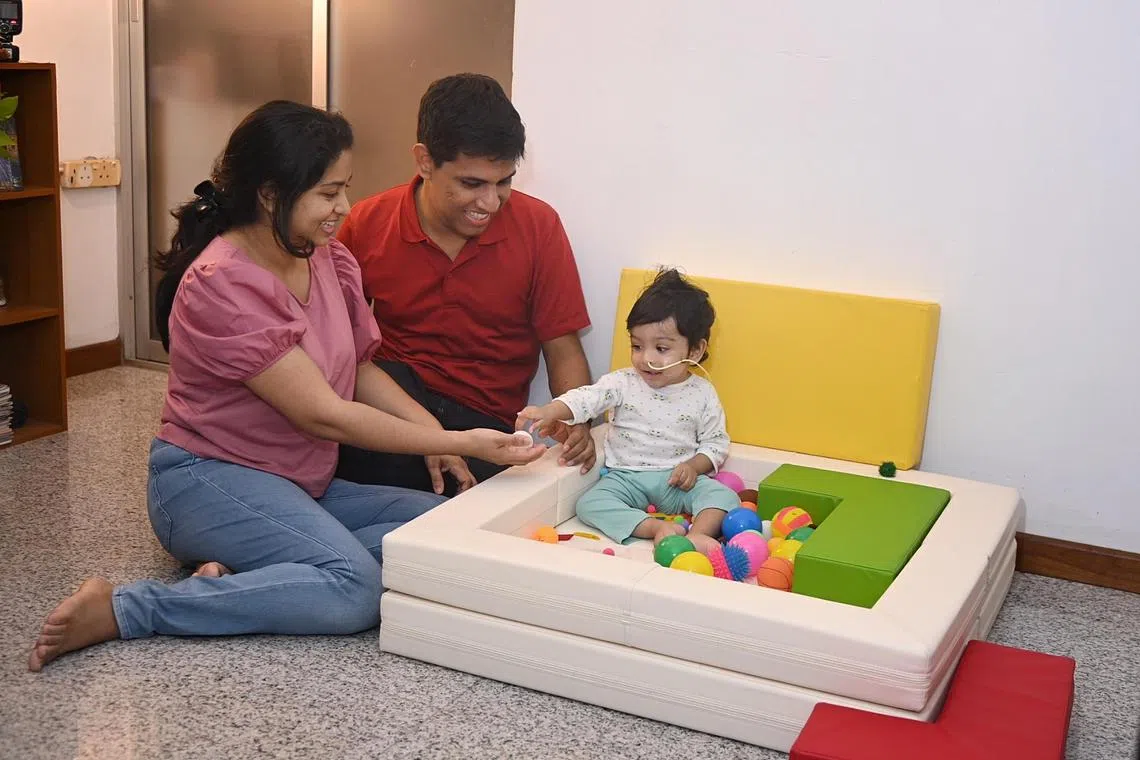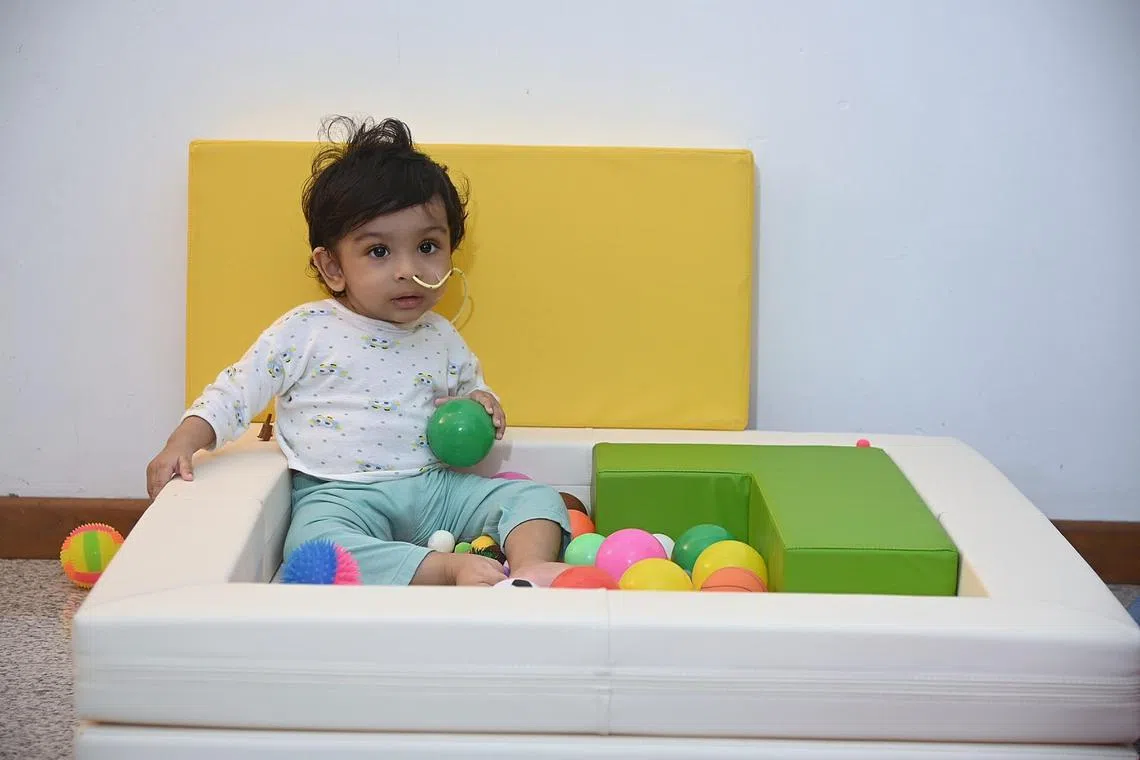Parents of 17-month-old with rare genetic condition race to raise $3 million for treatment
Sign up now: Get ST's newsletters delivered to your inbox

Mr Achintha Pilapitiya, and Ms Dulanjali Wakwella and their 16 month old son Shamel who suffers from spinal muscular atrophy.
ST PHOTO: DESMOND WEE
Follow topic:
SINGAPORE - When their son started gagging and refusing his food at about eight months old, the first-time parents knew something was amiss.
A month later, baby Shamel was not able to sit up and showed no signs of being able to put weight on his legs.
Soon after, he lost the ability to kick.
Numerous blood tests and a magnetic resonance imaging scan of his brain and spine showed normal results, prompting Shamel’s panel of doctors at the National University Hospital (NUH) to consider genetic testing.
Their diagnosis was grim: Shamel has a rare genetic disorder known as spinal muscular atrophy (SMA), which will cost millions to treat over his lifetime.
Shamel’s case – the third one that The Straits Times has reported in the past year – raises the question of what is the most equitable way for such treatments to be funded, especially as medical professionals say the number of cases is set to increase in the coming years.
Recalling the day she received the news, Shamel’s mother Dulanjali Wakwella, 33, said: “I never thought it was going to make my entire world collapse. (But when I finally got the news,) I did feel like my world was falling apart.”
The housewife and her husband, Mr Achintha Pilapitiya, 33, had earlier been warned that SMA was a possibility, and had read about the debilitating effects of the disorder and the cost of treatment.
“We thought, maybe it’s not going to happen to us, maybe we’re delusional and losing faith. But on the other hand, when Shamel was showing all the symptoms, it was alarming,” added Ms Dulanjali.
Shamel, now 17 months old, is currently tube-fed and requires support to sit up. When left unsupported, his upper body flops to the ground, causing him to wail uncontrollably.
A spokesman for NUH told ST that if SMA is left untreated, a child’s motor function can be expected to decline with age. Problems include respiratory insufficiency, swallowing dysfunction, motor contractures and fractures.
To make matters worse, treatment comes at a hefty cost.
Zolgensma, a one-time gene therapy, is priced at $3 million, and until last November, was known as the world’s most expensive drug.
The NUH spokesman said other options of treatment for SMA include Spinraza, a therapy given every four months, and risdiplam, or Evrysdi, an oral medication administered daily.
“Patients on these alternative therapies will have to be on them for life,” said the spokesman.
Spinraza is not available for patients in Singapore while Evrysdi, which Shamel has been taking since January, costs about $16,000 per bottle and lasts him 40 days.
Dr Furene Wang, consultant in paediatric neurology at Khoo Teck Puat – National University Children’s Medical Institute, said Evrysdi works by increasing functional survival motor neuron protein levels, while Zolgensma is a one-time intravenous gene therapy that allows the production of functioning survival motor neuron protein.
She added that both treatments have shown clinical benefits, especially when administered early in the disease course.
Zolgensma is available in Singapore only via the Special Access Route, which allows for unregistered life-saving drugs to be imported into the country.
Its maker, pharmaceutical company Novartis, has negotiated deals with national health systems and insurers to get the drug covered in some countries, but Singapore is not one of them.
The novel drug, which was approved by the United States Food and Drug Administration in May 2019, must be administered to children before they turn two.

Shamel is now tube-fed and requires support to sit up.
ST PHOTO: DESMOND WEE
In 2022, The Straits Times reported two separate cases of parents who successfully raised $3 million so that their children could get Zolgensma.
One of them, Devdan, now aged three, got the drug in September 2021 and is now able to stand independently and walk with support.
His mother, who wanted to be known only as Ms Shu Wen, a designer, 35, said: “We knew it would be effective as we had seen videos of SMA patients before and after they had Zolgensma.
“If only we knew that raising such a huge sum was possible, we would have started much earlier... Miracles do happen and we are so grateful to every single donor who helped us.”
Such stories inspired Shamel’s parents to start their own crowdfunding campaign managed by Ray of Hope, which has raised over $393,000 since Dec 1, 2022.
They have no other choice as Zolgensma is neither subsidised by the Government nor covered by their insurance.
Explaining the high costs involved, Dr Jeremy Lim, associate professor at the National University of Singapore Saw Swee Hock School of Public Health, said genetic therapies like Zolgensma are priced according to the cost saved for alternative multi-dose treatments over the patient’s lifetime.
He noted that clinical medicine has evolved from control to cure for a number of conditions such as SMA and haemophilia, which calls for new financing models.
Dr Lim said there will be “more and more” drugs costing millions, adding: “It’s in society’s interest to pay for at least some of them if you want to encourage innovation. However, there is no system in the world that is prepared for this magnitude of financing.”
He noted that Singapore’s Rare Disease Fund (RDF) currently covers five diseases, which do not include SMA.
“Clearly, the Government cannot fund every drug... The limitation of funds is intellectually understandable but very hard to accept if you’re the parent of a child with such a disease,” added Dr Lim.
He believes the correct way to finance such drugs is through insurance and risk pooling, which can be made feasible only through legislation.
“Unless there is legislative compulsion, no one will want to be a first mover and provide coverage, as this will mean higher premiums and result in an insufficient pool for those who need to claim,” Dr Lim said.
“Between funding nothing and funding everything, the Government has to find a middle path, and it cannot be top-down. It has to engage the public on the prices of these drugs, why some patients should be more ‘deserving’ than others.
“There is no real solution; it’s only what society is comfortable with,” Dr Lim added, noting that Singapore’s spending on healthcare as a whole remains lower than other developed countries.
Health Minister Ong Ye Kung acknowledged in Parliament last November
“Medicines for rare disease patients can exceed $200,000 per patient annually, with varying efficacies, and our healthcare financing system is not designed to support such high-cost treatments,” he said.
At the Yale-NUS College President’s Speaker Series last October, Mr Ong said that with regard to genetic treatment: “All healthcare systems in the world are not designed to fund $2 million a pop or $1 million per pop, so it will come a day, we need to really rethink through our finance system.
“My own sense is that when you are looking at a disease that a small proportion of the population will get, and requires such a high cost to cure, the solution must lie in insurance.”
For Shamel and his parents, the clock is ticking.
They have less than two months to raise enough funds to buy Zolgensma. The drug will have to be brought in from the US and Shamel will have to be placed on steroids prior to taking the treatment.
“With Zolgensma, we have hope that he will live longer, and he might be able to live an independent life,” said Ms Dulanjali.
Mr Achintha, a software engineer, added: “Every child should get a chance to play.”
To donate to Shamel’s cause go to /


